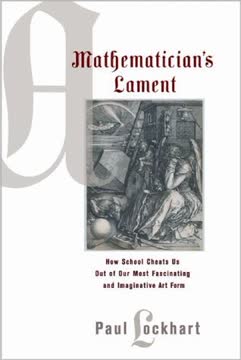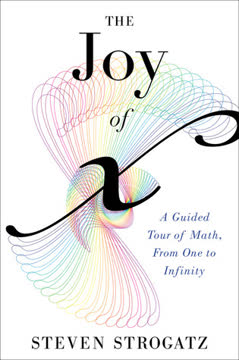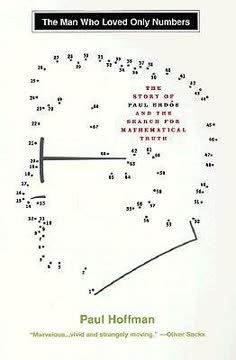Key Takeaways
1. Mathematics is an Art, Not a Sterile Subject
The first thing to understand is that mathematics is an art.
Misunderstood art. Mathematics is fundamentally an art form, akin to music or painting, yet our culture fails to recognize it as such. While poets, painters, and musicians are celebrated for their creative expression, mathematicians are often mistakenly associated with science, seen merely as technical assistants for formulas or data processing. This widespread misconception obscures the true nature of mathematics.
Purest of arts. Mathematics is, in fact, profoundly poetic, radical, and mind-blowing, offering more freedom of expression than other arts constrained by the physical universe. Mathematicians are "makers of patterns" with ideas, preferring to think about the simplest, most imaginary things. This pursuit is driven by an aesthetic principle: simple is beautiful.
Imaginative play. At its core, mathematics is about wondering, playing, and amusing oneself with imagination. When a mathematician considers a triangle in a box, they are not thinking of physical objects, but perfect, imaginary creations. These creations, once defined, reveal their own inherent properties, compelling the mathematician to discover, not dictate, their truths.
2. Current Math Education Destroys Natural Curiosity
In fact, if I had to design a mechanism for the express purpose of destroying a child’s natural curiosity and love of pattern-making, I couldn’t possibly do as good a job as is currently being done—I simply wouldn’t have the imagination to come up with the kind of senseless, soul-crushing ideas that constitute contemporary mathematics education.
A terrible nightmare. The current system of mathematics education is likened to a nightmare where music or painting are reduced to mindless symbol manipulation or paint-by-numbers. Students are forced to memorize notation and rules without ever experiencing the art form itself, leading to boredom and a complete lack of engagement. This system is a cruel deprivation of a natural human expression.
Students are right. Politicians, schools, and educators offer various solutions, but they all miss the point. The only ones who truly understand the problem are the students themselves, who rightly declare, "Math class is stupid and boring." Their natural curiosity and love for pattern-making are systematically crushed by a curriculum devoid of meaning and creativity.
Self-perpetuating monster. This cultural problem is a self-perpetuating cycle: teachers learn pseudo-mathematics from their teachers, and students from them, creating an endless replication of misunderstanding. Those who excel at this "mindless manipulation of symbols" gain self-esteem, often discovering later they lack true mathematical talent, which is about raw creativity and aesthetic sensitivity, not following directions.
3. School Math Lacks Genuine Problems and Creative Engagement
By removing the creative process and leaving only the results of that process, you virtually guarantee that no one will have any real engagement with the subject.
No problems, only exercises. The main flaw in school mathematics is the absence of genuine problems, replaced by insipid "exercises." Students are given formulas and told to apply them repeatedly, eliminating the thrill of discovery, the joy, and even the frustration of the creative act. The question is asked and answered simultaneously, leaving nothing for the student to do.
Art of explanation. Mathematics is the art of explanation, not merely a collection of facts. The beauty lies not in the "truth" itself, but in the argument, the creative process of invention and discovery. Denying students the opportunity to pose their own problems, make conjectures, be wrong, or craft their own explanations is to deny them mathematics itself.
Lost inspiration. Presenting only the results of mathematical creation, like the triangle area formula, without the underlying creative process, is akin to describing Michelangelo's sculpture without letting one see it. It removes any chance for inspiration or real engagement. The focus on "what" without "why" reduces mathematics to an empty shell, devoid of its context and meaning.
4. The Standard Curriculum is a Rigid, Fragmented "Ladder to Nowhere"
Far from being disturbed and upset by this Orwellian state of affairs, most people have simply accepted this standard model math curriculum as being synonymous with math itself.
Orwellian rigidity. The most striking feature of the mathematics curriculum is its extreme rigidity, with the same topics taught in the same way and order across schools, cities, and states. This uniformity is mistakenly accepted as synonymous with mathematics itself, reinforcing the "ladder myth" that math is a sequential race where students are either "ahead" or "behind."
Fragmented collection. This ladder myth creates a sad race to nowhere, cheating students out of a true mathematical education. Real mathematics is organic and problem-driven, not a canned sequence of "Algebra II ideas." The curriculum, lacking historical perspective or thematic coherence, becomes a fragmented collection of topics united only by their ease of reduction to step-by-step procedures.
Unmotivated definitions. Instead of discovery, students encounter rules and unmotivated definitions, like the "negative exponent rule" presented without aesthetic rationale or the fact that it's a choice. Pointless nomenclature, such as "mixed number" versus "improper fraction," clutters classes, serving only to provide testable jargon rather than fostering genuine mathematical understanding or critical thinking.
5. High School Geometry Undermines Intuition with Artificial Proofs
All metaphor aside, geometry class is by far the most mentally and emotionally destructive component of the entire K-12 mathematics curriculum.
Insidious virus. High school geometry, despite posing as an introduction to mathematical reasoning, is a "virus" that attacks the heart of creative argument. It systematically undermines students' natural intuition about shapes and patterns through an onslaught of pointless definitions, propositions, and a rigid, artificial format for "formal geometric proof."
Tortured art. This course openly and cruelly tortures the beautiful art of mathematics. Simple, obvious observations, like vertically opposite angles being equal, are subjected to lengthy, bureaucratic, and soulless "proofs" that make students doubt their own intuition. This pedantry forces students to adopt a stilted, hieroglyphic language, rather than engaging in witty, enjoyable arguments.
Misplaced rigor. While formal proof has its place, it is not for a student's first introduction to mathematical argument. Rigor becomes crucial when intuition fails or paradoxes arise, but not as excessive preventative hygiene for the obvious. This approach creates barriers to intuition, making simple things complicated, and completely misunderstands the mathematical enterprise, which aims to remove obstacles and keep things simple.
6. True Mathematical Proof is a Beautiful, Explanatory Revelation
A proof should be an epiphany from the gods, not a coded message from the Pentagon.
Poem of reason. A mathematical argument, or proof, is a work of fiction, a poem, whose goal is to satisfy. A beautiful proof should explain clearly, deeply, and elegantly, refreshing the spirit and illuminating the mind. It is a "poem of reason" that must appease a "Two-Headed Monster" of criticism: one head demanding logical airtightness, the other seeking simple beauty and elegance.
Mystery melts away. The goal of a mathematician is to explain in the simplest, most elegant, and logically satisfying way possible, making the mystery melt away to reveal a simple, crystalline truth. This process is not about persuading others like a lawyer or testing theories like a scientist; it is a unique art form within rational science, requiring inspiration and epiphany.
Transformative power. The discovery of a proof, like the elegant L-shape explanation for the sum of odd numbers being squares, can feel like a "divine revelation." This experience of glimpsing a secret, underlying truth is what keeps mathematicians engaged. It is a transformative power, fundamentally changing one's intuition and understanding of mathematical objects.
7. Mathematical Objects are Imaginary Entities with Intrinsic Behaviors
To me the important step is not the move from rocks to symbols, it’s the transition from quantity to entity—the conception of five and seven not as amounts of something but as beings, like hamsters, which have features and behavior.
Beyond symbols. Mathematical objects, like numbers, are not merely symbols or quantities, but imaginary entities with intrinsic properties and behaviors. Just as a field biologist studies hamsters, mathematicians observe these "creatures" in their "natural habitat" (imaginary piles of rocks), focusing on what they are and do, rather than their arbitrary names or representations.
Aesthetic choices. The "rules" of arithmetic are consequences of aesthetic choices made by mathematicians to "improve" their imaginary structures. For instance, negative numbers and fractions were invented to create symmetry in operations like subtraction and division, transforming "eight take away five" into "eight plus negative five," simplifying the system to a single operation: adding.
Freedom to invent. In Mathematical Reality, there are no rules or restrictions beyond those we impose. Mathematicians are free to invent new structures, like projective geometry's "points at infinity" to eliminate parallel lines, as long as they are consistent and interesting. This freedom allows for the creation of patterns that are not only beautiful but also challenging to the mind.
8. Mathematicians Explore "Mathematical Reality" for Joy and Understanding
This is of course an imaginary place, a landscape of elegant, fanciful structures, inhabited by wonderful, imaginary creatures who engage in all sorts of fascinating and curious behaviors.
A compelling jungle. Being a mathematician is akin to being a field biologist exploring a tropical jungle, but instead of Costa Rica, it's "Mathematical Reality." This landscape is filled with strange creatures and interesting behaviors, like the pattern of consecutive odd numbers summing to squares. Mathematicians are drawn to these patterns, seeking to understand why they occur, not just that they occur.
Pure amusement. The primary motivation for mathematicians is pure enjoyment and amusement. They build and discover delightful structures, observe patterns, and craft elegant narratives to explain their behavior. This pursuit is not for practical or economic value; it is a dialogue with one's own mentality, a perfectly innocent and delightful activity of the human mind.
Transcending utility. While mathematics can have practical applications, its true value transcends mundane considerations. Just as music is not written to lead armies into battle, mathematics is not primarily for science or technology. Its worth lies in the fun, amazement, and joy it brings, offering a means of escape and a profound way to engage with the human mind.
9. The Value of Mathematics is its Intrinsic Beauty and Transformative Power
Nothing I have ever seen or done comes close to having the transformative power of math.
Mind-blowing experience. Mathematics offers a unique transformative power, capable of blowing one's mind daily. The discovery of a hidden structure, like the L-shapes within squares, provides a feeling of divine revelation, a glimpse of a secret underlying truth. This experience goes to the heart of what it means to be human.
Quintessentially human. Mathematics, as the art of abstract pattern-making, is arguably our most quintessentially human art form. Our brains are biochemical pattern-recognition machines, and mathematics is the distilled essence of this innate capability. It is a terrifyingly simple yet profound engagement with the fundamental workings of our own minds.
Beyond facts. The true value of mathematics lies not in its "truths" or facts, but in the process of discovery, explanation, and analysis. Mathematical truths are merely incidental by-products of these activities. Like painting, the art is in the doing, the experience with the ideas, not just the finished product hanging in a museum.
10. Teaching Math Requires Intellectual Honesty and Fostering Discovery
Teaching is not about information. It’s about having an honest intellectual relationship with your students.
No method needed. Effective teaching in mathematics requires no specific method, tools, or training; it simply demands the ability to be real and have an honest intellectual relationship with students. If teachers are unwilling to be real people, sharing excitement and wonder, they have no right to inflict themselves upon innocent children.
Guide, don't dictate. Teachers should guide students through engaging problems, allowing them time to make discoveries, formulate conjectures, and refine arguments. This means being flexible and open to students' curiosity, fostering an atmosphere of vibrant mathematical criticism. Specific techniques should arise naturally from this process, as they did historically.
Trust students' capacity. Students are not aliens; they respond to beauty and pattern and are naturally curious. They are capable of creative reasoning, just as they are capable of writing history papers or essays about Shakespeare. The problem is often that teachers themselves have never experienced true mathematics, having been trained in a system that lacks it.
Last updated:
Review Summary
A Mathematician's Lament is a passionate critique of math education, arguing that math should be taught as an art form rather than a set of rote procedures. Many readers found it eye-opening and inspiring, praising Lockhart's argument that math is creative and beautiful. Some appreciated his humor and engaging writing style. Critics felt he offered few practical solutions and was dismissive of real-world applications. Overall, the book sparked reflection on how math is taught and understood, with many wishing they had been exposed to this perspective earlier.
Similar Books
Download PDF
Download EPUB
.epub digital book format is ideal for reading ebooks on phones, tablets, and e-readers.








